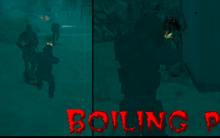For the manufacture of silk-screen wallpaper, vinylized paper is used. She's being dyed special method and then heated to certain temperature followed by heavy embossing. By by and large you can stick such wallpaper in the usual way. However, there are still some subtleties. How to glue silkscreen wallpaper can be found in our article.
Preparatory work
When choosing this type of wallpaper, you should definitely check the article number that is printed on the package. Make sure that it is the same on all wallpaper rolls you buy. The batch number must also match. If it is different, then you run the risk of buying different shades of wallpaper, which is unlikely to have a positive effect on the appearance of your room. Experts advise not to throw out the labels from the wallpaper until the finishing work is completed.
Before cutting the rolls, spread them on the floor and check if they have any defects in the form of a beveled pattern or a sharp change in its brightness. This inspection is best done for all rolls at once. If you have already pasted the roll, you will not be able to make a claim to the store. An important point is the choice of wallpaper glue. Silk screen printing requires special glue, so if you buy an ordinary one, you will just ruin the wallpaper.
Wall preparation
Before you paste over the walls with wallpaper, you need to carefully prepare them. Silk-screen printing is glued to perfectly smooth and cleaned walls. To do this, it is necessary to remove all old finishing materials, whether it be wallpaper, paint or other material. Oil stains are also unacceptable. At proper preparation walls on the wallpaper will not appear bubbles.
If the walls need to be covered with plaster, then after this is done, you need to leave them alone until they dry completely. Then the surface of the walls is puttied and primed. Do not under any circumstances use water-based paint for primer.
Roll cutting
Before cutting the rolls into pieces, you need to measure the height of the room where you stick them. If the wallpaper has a very clear pattern that needs to be combined, then when cutting, an allowance of 10 cm should be left on each roll. On the reverse side of the strip, mark the number with a pencil so as not to confuse them when gluing.
How to glue wallpaper
First you need to draw a vertical line on the wall. This can be done using building level. The strip will serve as a guide for the first sheet of wallpaper when pasting. The remaining stripes will be equal to the first. As a rule, there is a label on the wallpaper, which contains instructions on how to apply the glue. After you have generously smeared a strip of wallpaper with glue, you need to leave it for about 10 minutes so that the glue is slightly absorbed into the texture of the wallpaper. At this time, you can apply a layer of glue on the wall in the very near corner from the window.
Now you can glue the wallpaper. First of all, the upper part of the strip is applied to the wall. Then the canvas is gradually pressed against the surface with a roller, moving from the top to the middle. Next, the strip is smoothed with smooth movements from the center to the edges. In this case, air bubbles are squeezed out from under the wallpaper. Remember that silkscreen wallpapers are always glued end to end.
Top and bottom of the wallpaper must be cut with a sharp knife. If glue accidentally gets on the joints of the canvases, then it should be removed immediately with a soft, damp cloth. The same applies to platbands and skirting boards.
How to glue wallpaper in hard to reach places
As you know, it is most difficult to glue wallpaper on the corners. In this case, the wallpaper canvas close to the corner should be launched with a slight approach to the next wall, perpendicular to the previous one. Then, when gluing the next strip, it is necessary to very carefully align it with the first strip. To ensure that the wallpaper is pasted strictly vertically, use a plumb line. To remove unnecessary parts, a ruler is applied to the double layer of pasted wallpaper in the corner and a thin incision is made with a knife. If the glue comes out, then it must be removed immediately. Unnecessary edges of the wallpaper are cut off.

To stick the wallpaper behind the radiator, they must be cut in the place where it is attached to the wall. Next, the canvas is wound behind the radiator and smoothed with a flat brush wrapped in a clean, thin cloth. However, the wall behind the radiator is most often not completely pasted over. Just run the canvas about 20 cm per section.
Before sticking wallpaper on places near switches and sockets, you must first turn off the power supply. Then the sockets and switches themselves are removed, and the wallpaper is glued over the holes. In places where there are sockets, the wallpaper must be cut with a cross and the free edges bent inside the box. Then the sockets and switches are installed in their original place.
Silkscreen wallpapers have excellent external data and are able to transform any room. Due to the unique production technology, the coating has a beautiful shiny surface, visually similar to silk fabric. In addition, they are easy to care for, which allows you to finish in the kitchen.
What it is?
This is a type of vinyl wallpaper with a pattern applied in a special way by silk screen printing or hot stamping. Production is carried out in several stages. Vinylized dyed paper is applied to the base of paper or non-woven fabric, which is impregnated with polyvinyl chloride, after which the canvas goes through the embossing process. The thickness of the vinyl layer can be different, this allows you to adjust the strength of the material.
The photo shows a bedroom in the style of a new classic. Accent wall of beauty turquoise color harmonizes with other interior details of the same shade.
The pattern is created using silk or synthetic fibers. Visually, the coating resembles a silk cloth, the material is durable, shiny. The drawing can be monochrome or color, as well as imitate different materials such as leather or wood.

Types of bases
non-woven
Non-woven silkscreen wallpaper is more durable. The material is elastic, better in contact with moisture and can hide small wall defects. In addition, non-woven-based coatings are more reliable and more convenient when working with them, you can not be afraid that the canvas will tear, stretch or warp. This type of wallpaper has a longer service life, but their cost is an order of magnitude higher than paper ones.

The photo shows a compact bright living room with modern design. Due to the light furniture and the pattern on the wallpaper, the room does not seem dark.
Paper
A budget option finishing material. The paper base does not differ in strength and durability, and also interacts poorly with moisture. When gluing, you need to be careful, as the coating is very delicate and can tear. Wallpaper silkscreen on paper basis must be applied on a flat surface, they are not able to hide the unevenness of the walls.

Peculiarities
The silkscreen coating has a number of distinctive features, which have a positive effect on the characteristics of the material.
- The surface of the silk-screened wallpaper is a luxurious shiny canvas, such an effect can only be achieved by silk-screen printing.
- Large roll width, most often meter. It is very convenient when gluing, the number of joints is less.
- The coating does not fade in the sun.
- No harmful chemicals are used in the production of wallpaper.

Pros and cons
Such consideration of the characteristics and nuances of the material helps to make a choice.

The photo shows a sleeping area with a modern design. The interior uses several techniques to increase space.
Photo ideas in the interior of rooms
For kitchen
A practical and beautiful finishing solution. Silk-screened wallpapers are easy to care for, they can be wiped with a dry or damp cloth without fear that traces will remain. For the kitchen, you should choose silk-screened non-woven wallpaper, they will last longer, and most importantly, they are in better contact with water. In addition, this type of wallpaper breathes and eliminates the appearance of fungus. Wallpaper will look great in a classic kitchen interior.




For the hall
posh appearance silk-screen printing will look spectacular in a living room with a classic design, and also, with the right combination of materials, will become a “highlight” in the modern stylistic direction. Silkscreen wallpaper can frame an entire room, or become an occasional decoration, such as an accent wall. Shiny details will shimmer beautifully in the sun, creating the illusion of a three-dimensional wall.



In the photo, the hall is combined with a dining room. Design in light color scheme with bright decorative accents.
For the bedroom
Depending on the pattern, silk-screened wallpaper will support a bohemian atmosphere in the bedroom interior or create an incredibly light and romantic design. Finishing can be done completely with one type of coating or use the companion wallpaper finishing method, combining different colours and invoices. The latter method will make the bedroom more interesting and help correct the layout flaws.




For bathroom, toilet
In the bathroom and toilet, you should use silk-screened wallpaper only on a non-woven base, paper will not work, as it will not withstand moisture and will quickly lose its presentable appearance. For greater reliability, wallpapering can be combined with other materials and made in a horizontal way, for example, wallpaper on top, tiles or panels on the bottom.



For hallway, corridor
Silkscreen wallpapers are convenient for the hallway because they are easy to care for. An unwanted stain left after returning from the street can be easily removed with a damp cloth. For small and closed hallways, it is worth using a light palette for decoration, vertical or horizontal stripes will make it taller or wider.



Color spectrum
Pink
Silkscreen on a pink background will be associated with a pearl. Making in a similar color will look very gentle. Suitable for decorating a bedroom, classic living room or kitchen. Pink color silkscreen wallpaper will go well with light-colored furniture and decor items.

White
Wallpaper looks luxurious, while gentle. The pattern will only shimmer on a light background, creating the illusion of volume in the room. The white color of the walls will successfully decorate the design with almost any style.

Blue
The blue tone will be especially expressive as a background for golden or silver patterns. A dark shade can be combined with a lighter color scheme, such as companion wallpaper or a pattern in a contrasting color.

Blue
Delicate blue tone visually makes the space of the room larger, fills it with freshness. Ornate patterns in the company of furniture white color underline the gentle airy atmosphere in the interior.

Beige
Silk-screen printing on a beige background will cast gold, the room will be filled warm light. Beige color suitable for finishing any room in the house, it will look especially harmonious in a classic, Victorian and neoclassical style.

The photo shows white silk-screen wallpaper in a classic interior with a golden sheen.
Greens
Green silkscreen wallpaper will make the interior aristocratic. Shades of green will fill the room with warmth. dark tone best used as a partial finish, combining it with a lighter color, such as beige. Full finish in green better left for spacious and bright rooms.

black
Unlike a warm light palette, black silkscreen can look incredibly stylish in modern and neoclassical designs. Best of all, the black tone of the silk-screened wallpaper will look in open spaces with large windows and abundant daylight.

The photo shows a stylish dining room in black and white design. Due to the contrasting white ceiling and large windows the room is filled with light.
Golden
Gold will emphasize luxury in the interior of an apartment or house. The design will be filled with aristocratic and underlined chic notes. Classical and Victorian style will become best solution for a similar finish.

gray
Gray color will decorate both a classic design and a room with modern style. The palette can be warm or cold, with any choice, a gray tint will give the design a discreet and stylish luxury.

Design Ideas
Flowers
Ornate floral patterns, tulip buds or large roses will decorate a classic living room or bedroom. Floral print will add romance and tenderness to the interior. The design will be complemented by wall moldings or paintings with classic style letters.

Geometry
Classic horizontal or vertical stripes will become good choice for modern and classic interiors. The direction of the stripes will help to "push" or "stretch" the walls of the room, thereby correcting the imperfection of the room, this technique will work for rooms of any size.


Abstraction
Abstraction on silk-screened wallpaper will make the interior voluminous. This type of finish will fit well into modern and high-tech style. The decoration of one or more walls with silk-screen printing can be combined with other types of wallpaper.

Options in various styles
High tech
The style is not distinguished by congestion, unnecessary details and smooth lines. The interior is dominated by straight lines in decoration and furniture, modern high-tech content, and restrained colors, although bright details can decorate the design.

Classical
For a classic design, silk-screened wallpapers are best suited. A soft sheen will emphasize luxury, while not looking defiant. The classic room is filled with furniture from natural wood and fine decorative details. Walls can be decorated with moldings or combined with wood panels.

The photo shows the interior of the bedroom in the Victorian style. The walls are decorated with peach-colored silkscreen wallpaper.
Modern
Style design can be filled with bright colors and a mixture of materials. Silk-screened wallpaper in a rich shade will be a great idea for decorating any area or accent wall. The pattern can be in the form of Damascus, abstraction or geometric ornament.

Oriental
The style is distinguished by special luxury and wealth. Ornate patterns and golden tints will only emphasize the features of the style. In oriental design, the emphasis can be placed on finishing or filling the room. For example, wall decoration in a bright shade or unusually shaped furniture and colorful textiles.

How to glue?
What glue to use?
For screen printing, you need to choose an adhesive for heavy types of coatings, since that is what they are. Today, a fairly wide range of adhesives for wallpaper of this kind is presented in hardware stores. There is an adhesive specifically for silk-screen printing coatings, its composition takes into account all the features of the material, including the need for antifungal treatment.
Step by step instructions for gluing
The process of gluing silkscreen wallpaper does not differ fundamentally from any other. For an ideal result, it is worth following the entire procedure step by step.
- First you need to prepare the surface for gluing. To do this, you need to level and sand the walls, as well as apply a primer.
- Prepare glue. To do this, it is kneaded in accordance with the instructions.
- Prepare wallpaper. To do this, the roll is cut into strips of the desired length. It is necessary to take into account the compatibility of the pattern and take a margin of 5 centimeters.
- Apply vertical lines. This will require a level or plumb line. The strip will help to stick the strips evenly and without displacement.
- Sticking starts from the corner of the room, applying a strip from top to bottom.
- Excess air and irregularities are "expelled" by smoothing to the sides.
- After gluing, the excess is carefully cut off.
Video
Caring for the silkscreen coating is not difficult. Regular and careful cleaning will help prolong the life of the blade. The coating has an advantage over other types of wallpaper, this is an opportunity wet cleaning.
- The coating can interact with water, the degree of interaction is necessary. It is indicated in the form of a marking on the packaging of the roll or the reverse side of the web.
- For dry cleaning, you can use a soft brush, cloth or vacuum cleaner.
- For wet cleaning, you can use a cloth or sponge, as well as non-abrasive cleaners or soapy water.

The photo shows a bright bedroom in the style of a new classic. Finishing is made with two types of wallpaper.
Photo gallery
Silk-screened wallpaper will emphasize the style of the house, indicating its luxury or discreet elegance. Drawings also indicate the character of the house, a wide variety allow you to choose exactly the one that will complement the interior. Wallpaper without a pattern would not look so impressive. In addition to stunning external data, the silkscreen coating has excellent usage characteristics.









Silkscreen is very beautiful option room finishing. Wallpaper combines a certain zest of luxury and brilliance. In addition, the material has excellent durability parameters. Probably for this reason, many modern designers are trying to use silk-screen printing in the arrangement. modern apartments and houses.
The material is quite refined and beautiful, but it has a number of features, therefore, it is very important to correctly carry out all pasting processes. You can use the request - how to stick silk-screened wallpaper, and find a lot of interesting answers, or you can use our recommendations and make the pasting process simple, fast and of high quality.

To get a qualitative effect, you need to act like this:
- We carry out the dismantling of the old coating;
- We clean the walls from dust and debris;
- We carry out the process of wall restoration - we eliminate cracks and cracks;
- We prime the surface;
- We use a deep penetration primer;
- We carry out the gluing process
In principle, there is nothing complicated, but at the same time, if you have a question about how to stick silk-screened wallpaper, you should immediately note that in this matter, the most important thing is to properly prepare the surface.

To do all the work quickly and correctly, you will need certain tools:
- roller;
- tassel;
- dry, clean cloth;
- bucket;
- putty knife;
- pencil and centimeter;
- level;
- scissors.
All these tools are the undeniable basis for the pasting process. They are inexpensive, but they are necessary, they should be purchased in advance.

So we came to the answer to the question of how to paste silkscreen wallpaper. We start the preparation process.
- Dismantling of the old coating is carried out in a well-ventilated area. If the wallpaper is difficult to remove, use a sprayer, apply warm water on the surface and after 10 minutes the wallpaper will be perfectly removed.
- Let's start cleaning the surface. In this case, use a damp sponge to remove dust deposits on the walls.
- Now let's take a closer look at the walls. If there are cracks, they need to be expanded and repaired. We recommend that you use dry mixes based on Portland cement. Such mixtures are supplemented mineral additives, plasticizers and modifiers, which allows you to get the perfect result.
- Remember that the wall must be perfectly flat. Therefore, we use putty for leveling.
- When the putty has dried, we proceed to the priming process, in this case, you will need a material that is used exclusively for silk-screen printing. After that, we prime the surface again with penetrating materials.
That's all, the surface is prepared, it remains only to cut and start the pasting process.

Before starting work, it is best to ventilate the room well, but you need to glue the wallpaper indoors.
Be sure to buy quality glue, which was created specifically for this type of wallpaper.
Before application, the adhesive is prepared for 15 minutes.
Apply glue to the wallpaper 15 minutes before pasting, so that it deeply impregnates the material.
Also, glue is applied to the walls, in a fairly thick and thick layer.
Wallpaper should be cut before pasting. Immediately take all the necessary measurements and cut the material into convenient strips. To do this, use a centimeter, a knife and scissors.
All tools must be ready in advance. Floors are best covered plastic wrap so as not to blur. In principle, that's all, we glue the wallpaper in the traditional way.
Silk-screen vinyl wallpaper allows you to make any interior beautiful and unique. These materials are a kind of vinyl wallpaper, which are glued to the walls quite simply, made on the basis of vinylized paper, painted using a rather complex technology.
Wallpaper vinyl screen printing is produced by hot stamping, applying to the base of polyvinyl chloride interspersed with threads of silk or artificial, and then using high pressure, the material is embossed. The article offers to get acquainted with the features of the material and its gluing on the walls with your own hands.
Silk-screen printing allows the dye to be applied in a thick layer of any consumable.
At the same time, the embossing technique includes several technological operations:
- Frame tension.
- Choice of sieve fabric.
- Selection of colors.
- Obtaining sustainable forms.
- Drying.
Silkscreen and vinyl wallpapers have several advantages:
- The production process is quite simple.
- A variety of consumables are used.
- The layer of applied paint has a significant thickness.
- Coatings with bright and juicy colors.
- For small and medium runs, the price is not high.
- There are solutions that cannot be done using other printing methods.
- Silkscreen wallpaper has sufficient durability.
- They have an impressive appearance.
The screen printing technology looks something like this:
- A canvas made of paper or non-woven fabric is impregnated with polyvinyl chloride - PVC.
- Thin silk threads or artificial fibers are interspersed in the resulting stripes.
- Vinylized paper is exposed to intense heat.
- The surface is embossed under high pressure.

After completing all the operations, a canvas is obtained that looks like paper and textiles, which is associated with the use of both.
Tip: To improve the characteristics of the material, you should take a non-woven base for wallpaper, it is much better than paper.
Silkscreen Features
Silk-screen wallpaper consists of two layers:
- Bottom made of paper or non-woven, which allows you to reliably glue the material to the surface.
- The upper is made of vinyl with the inclusion of silk threads., its structure can be embossed or smooth, very similar to silk fabric. Silk-screen printing is made under textured plaster, leather.
In the interior, silk-screen printing and vinyl wallpaper look great on the wall. Most often, these materials have floral ornaments and paintings to imitate silk fabric as much as possible, with beautiful and clear patterns, which creates the complete impression of silk fabric with gilded threads on the walls, as seen in the photo.

Screen printing advantages:
- High strength, which provides the vinyl used in the manufacture.
- Increased wear resistance.
- Durability.
- Resistant to sun exposure.
- Rolls are available in large widths.
Despite the high cost of silk-screened wallpapers, they are quite popular. Coating can give the interior a unique exquisite charm and luxury.
They are suitable for finishing any room in the apartment:
- Living room (see How to choose wallpaper for the living room: designer's tips).
- Bedrooms.
- Kitchens (see What is the best wallpaper for the kitchen: making a choice).
The unique effect of the high cost of the material is given by silkiness and a pleasant shine of the surface.
Tip: When gluing silk-screened wallpaper in the kitchen, it must be taken into account that the moisture resistance of the material must be higher. In this case, you should choose wallpaper with a matte or glossy finish. flat surface, with a rough structure, cleaning and caring for the wallpaper will be difficult.
Silk-screen printing in the bedroom can be done with canvases of any thickness and density, they do not really matter. In the bedroom, the wallpaper is not subjected to such intensive use as in the hallway or in the kitchen.
What are the advantages of silkscreen wallpaper
Features of silk-screen printing determine the advantages of wallpaper from this material.
These include:
- Safety for humans and animals.
- Not isolated to humans harmful substances, non-toxic.
- Have no smell.
- Easy and simple to clean, can be cleaned with a dry and damp cloth.
- Service life up to 15 years.
- Excellent appearance.

In addition to the advantages of silk-screen wallpaper, there are some disadvantages:
- They require careful and flawless preparation of the base before sticking to the walls, this is due to the fact that the wallpaper is quite thin.
- The material does not breathe.
- When burned, they can release toxic substances.
Sufficiently thin wallpaper after gluing on curved or poorly prepared walls will reveal all wall defects.
Tip: Silk-screen wallpaper will create a chic and expensive interior after gluing by the master and the most thorough preparation of the wall. In this case, the canvases must be glued strictly vertically using a quality level, better than a laser one, or a plumb line.
Silk-screen wallpapers are chosen so that they are in harmony with the rest of the interior of the room. It is difficult to match them with standard room furniture (see Selection of furniture to match the color of the wallpaper: professional advice). When purchasing these luxurious wallpapers, preference must be given quality materials from a proven and reliable manufacturer.
How to stick silkscreen on the walls
The work instructions offer:
- Choose the right glue for the wallpaper base material.
- The cover dries fairly quickly.
Tip: To avoid problems when sticking such wallpapers, special attention should be paid to their quality. When the manufacturer saves on top coat, the material will lose its elasticity, and it will be poorly impregnated with glue. Both layers of the coating should react equally to moisture and mechanical stress.
- All required tools and materials are prepared:
- putty;
- primer;
- special glue;
- spatulas of different widths;
- stationery knife and glue, for sealing seams.
- Walls are being prepared for wallpapering:
- are aligned;
- putty;
- covered with primer.
This will allow, after applying the material, to avoid the presence of visible defects in the walls and bubbling of the canvases:
- Wallpapering begins from the side of the windows to the door. In this case, the joints will be less noticeable.
- The vertical angle between the wall and the window should be ideally even, which is controlled by the slope. When deviating from perpendicularity, a plumb line should be noted, which must be done when gluing all panels.
- The wallpaper is applied to the corner, the length is measured.
- A piece of wallpaper is cut off according to the marks and smeared with glue.
- The sheet is left to soak for a few minutes.
- The canvas is applied to the wall and with a special rubber roller, leveled from the center of the sheet to the edges.
- The corner gap between the wall and the window is sealed.
Tip: If the sheets overlap, you need to draw a clerical knife under the ruler vertical stripe so that both sheets are cut at once. Excess pieces of wallpaper are removed.
Thus, the wallpaper is glued around the entire perimeter of the room. The edges of the wallpaper, so that they do not move away, can be treated at the joints with a special adhesive for seams and make a paper backing.

We should not forget that silk-screened wallpaper should be in good harmony with all the decoration of the room:
- Furniture.
- Coated on the floor.
- Ceiling.
All interior details must match the chic environment. Expensive furniture used in the palaces of French kings in the 16th and 17th centuries is best suited for this. How to choose the right interior for silk-screened wallpaper will help video.
Features and advantages of silk-screen printing. What are its types.
Subtleties and nuances of pasting. How to care for the walls after pasting with canvases.
Silkscreen is vinyl wallpaper that looks like it is draped in silk on the walls.
What is silk screen printing on wallpaper: advantages and features
This wallpaper has 2 layers, the bottom layer is made of paper or non-woven, it is firmly glued to the wall, upper layer consists of vinyl, has silk threads. They are embossed or smooth. They look like silk fabric.
In addition, silk-screen printing, which is stylized as textured plaster, skin.
Peculiarities:
- the top layer of the canvas is very durable, as it consists of vinyl;
- wallpapers do not wear out, retain their appearance for a long time;
- do not fade under the rays of the sun;
- rolls are sold with a large width.
Advantages:
1. non-toxic to humans and animals;
2. have no smell;
3. they are easy to wash;
4. last 10-15 years;
5. create the effect of an expensive room.
Where applicable
Can be sold that look like velvet, wrinkled silk, wet and wrinkled silk, brocade.
Silk-screened canvases are suitable for pasting any room, they come in a variety of shades and patterns.
 They can have geometric or abstract figures, ethnic drawings. The canvases with flowers are especially beautiful. Canvases with a gold ornament look very expensive. Therefore, they are suitable for any interior.
They can have geometric or abstract figures, ethnic drawings. The canvases with flowers are especially beautiful. Canvases with a gold ornament look very expensive. Therefore, they are suitable for any interior. If you glue canvases with a vertical strip, then the ceilings will visually appear higher.
Of course, for gluing silk-screen printing in the kitchen, it is required that the canvases be moisture-permeable. For this room, it is better to choose a pattern with a flat surface, as a printed pattern will make it difficult to clean.
If it is planned to paste over the bedroom with silk-screen printing, then it does not matter what thickness and density it will have.
Pasting features
Materials and tools:
- vinyl adhesive, suitable brands: KLEO Smart, Quelyd Special vinyl;
- silk-screen printing;
- a container in which you can stir the glue;
- knife, scissors;
- ladder;
- brush for applying glue; wide spatula for applying glue in the corners;
- plumb;
- rubber roller for smoothing wallpaper.
 Stages of work:
Stages of work:
- First, the walls are required: tear off the old wallpaper, clean off the dirt and dust. Next, a primer is applied, then putty is applied. When it dries, it is cleaned with emery from irregularities, then the surfaces are primed again, and a layer of finishing putty is applied.
- Prepare an adhesive, such as Quelyd Special Vinyl.
It is required to pour 4-4.5 liters warm water into the container. It is necessary to slowly pour in 300 g of glue while actively stirring the composition. Wait a quarter of an hour. Stir for another 2 minutes, then the composition will be ready.
It is necessary to roll out the roll on a flat, clean, dry surface. The length of the strip is measured along the height of the wall, cut off with a margin of 3-5 cm along the top and bottom. If there is a complex pattern, then the canvas should be correctly measured in order to join the pattern. - Spread evenly with glue reverse side cut strip. Do this from the middle to the edges with a special brush. Wait 5-7 minutes for the glue to soak the wallpaper layer.
- Lubricate the wall with glue.
- The first strip is glued, starting to the left of the window, it is required to step back 40-45 cm. It is necessary to draw a vertical line with a plumb line, and the wallpaper is aligned along it.
- The canvas smeared with glue is applied from above to the wall and smoothed. Smooth with a rubber roller moving from the center to the edges to get rid of air bubbles. Start smoothing from the canvas to the floor.
- Then the walls are pasted over with stripes in a counterclockwise direction. Wallpaper strips are glued only end-to-end, if they are glued with an overlap, it will be visible. It is required that the strips are well joined.
Corner pasting
 A canvas smeared with glue is applied on top, with an overlap of 1.5-2 cm on another wall. Glue it, smoothing it with a rubber roller. Cut off the excess canvas with a spatula directly in the corner. Also make out the corner of the adjacent wall.
A canvas smeared with glue is applied on top, with an overlap of 1.5-2 cm on another wall. Glue it, smoothing it with a rubber roller. Cut off the excess canvas with a spatula directly in the corner. Also make out the corner of the adjacent wall.
Care
If a fresh grease stain is placed on the wallpaper, then you should attach a napkin and run an iron over it.
True, when purchasing wallpaper, you need to carefully consider the label. If it shows 1 wave, then the wallpaper can be wiped with a damp sponge. If 2 lines are drawn, then sparing detergent formulations. If there are 3 lines, then the wallpaper can be rubbed with a brush, but not too hard.
Thus, silk-screened wallpapers are glued in the same way as vinyl ones, using similar brands of glue.
Useful video











Chief Power Engineer: duties and job description
How to Write and File an Overpayment Credit Claim Download the Credit Claim Form
Features of investigating a work injury on the way to work, home, and also during a lunch break Work injury during a lunch break
Reservation service (role, functions, characteristics) Requirements for a reservation manager
Products for pregnant women The best products for pregnant women